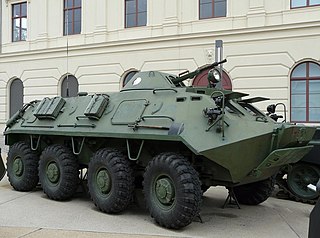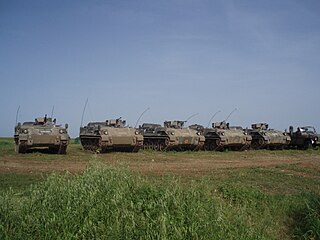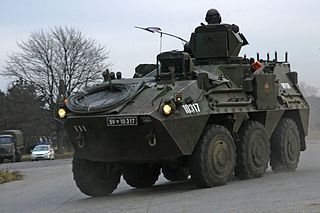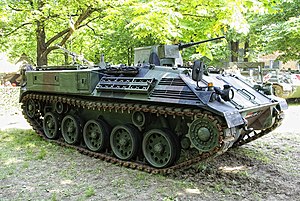
The Schützenpanzer Marder 1 is a tracked German infantry fighting vehicle designed for use with the West German Panzergrenadiere units, mechanized infantry specialized for IFV combat. It has been operated by the German Army as the main Panzergrenadiere IFV from 1970s through to the present day. Developed as part of the rebuilding of West Germany's armoured fighting vehicle industry, the Marder has proven to be a successful and solid infantry fighting vehicle design.

The BTR-60 is the first vehicle in a series of Soviet eight-wheeled armoured personnel carriers (APCs). It was developed in the late 1950s as a replacement for the BTR-152 and was seen in public for the first time in 1961. BTR stands for bronetransportyor.

The ASCOD armoured fighting vehicle family is the product of a cooperation agreement between Austrian Steyr-Daimler-Puch AG and Spanish General Dynamics Santa Bárbara Sistemas. The ASCOD family includes the LT 105, a light tank equipped with a 105 mm gun, a surface-to-air missile launcher, an anti-tank guided missile launcher, mortar carrier, R&R vehicle, command and control vehicle, ambulance, artillery observer, and the AIFV model. In Spanish service, the vehicle is called "Pizarro", while the Austrian version is called "Ulan".

The BTR-50 is a Soviet tracked amphibious armored personnel carrier (APC) based on the PT-76 light tank chassis. The BTR-50 was developed in 1952 and entered service with the Soviet Army in 1954. It ceased production in 1970. It has the ability to transport up to 20 fully equipped infantrymen, and can be armed with nothing, a 7.62 mm SGMB medium machine gun, or a 14.5 mm KPV heavy machine gun. It saw notable service in the Six-Day War, the Yom Kippur War, and most recently in the Russo-Ukrainian War.

Hellenic Vehicle Industry is a Greek vehicle manufacturer based in Thessaloniki.

The Leonidas-2 represented an effort made by the Greek vehicle manufacturer ELVO to produce an advanced armoured personnel carrier (APC) of its own. It is named after Leonidas, king of the ancient city-state of Sparta. The first version of the Leonidas was the Austrian Saurer 4K 4FA armoured personnel carrier built with minor modifications by the Greek company from 1981 until 1987. Initial production was essentially assembly, however Greek content progressively increased. The APC had a 320 hp engine and a weight of 14.8 tons.

The Pandur is an APC developed and produced by the Austrian company Steyr-Daimler-Puch Spezialfahrzeuge (SSF). It was developed during the 1980s as a private venture. In 2003, General Dynamics took over Steyr-Daimler-Puch which is now part of General Dynamics European Land Systems, which is also the parent company of MOWAG, Santa Bárbara Sistemas and GD ELS – Germany.

The SK-105 Kürassier is an Austrian light tank armed with a rifled 105 mm gun in an oscillating turret. It is estimated that over 700 have been produced, with initial deliveries in 1971. It shares its CN 105-57 main gun with the French AMX-13, which was widely produced and deployed.

The AIFV is a US tracked light armored vehicle that serves as an infantry fighting vehicle (IFV) in the armies of several countries. It is a development of the M113A1 armored personnel carrier.
A huge number of M113 Armored Personnel Carrier variants have been created, ranging from infantry carriers to nuclear missile carriers. The M113 armored personnel carrier has become one of the most prolific armored vehicles of the second half of the 20th century, and continues to serve with armies around the world in many roles.

The Type 63 is a Chinese armoured personnel carrier that entered service in the late 1960s. It was the first armoured vehicle designed in China without Soviet assistance. The design is simple and is comparable to other APCs of its time such as the M113.

The Dragoon 300 AFV was produced by Arrowpointe Corporation during the 1980s. It was based on the automotive components of the United States Army's M113 APCs and 5-ton trucks. It resembles a larger V-150 Commando.

Lahko kolesno oklepno vozilo Valuk is an improved version of Pandur 6X6 APC, manufactured under a license manufacturing agreement with the Austrian company, Steyr Daimler Puch Spezialfahrzeug AG & Co KG, by Sistemska Tehnika of Slovenia for the Slovenian Army.

The M59 was an American armored personnel carrier that entered service in the spring of 1954 replacing the M75. It had three key advantages over the M75: it was amphibious, had a lower profile, and was considerably cheaper to produce. Production ended in 1960, by which time approximately 6,300 had been built. The M84 Mortar Carrier was a derivative of the M59. The M59 was replaced in service by the M113 family of vehicles.

The Mitsubishi Type 89 IFV(89 FV ) is a Japanese infantry fighting vehicle that entered service with the Japan Ground Self-Defense Force in 1989. There were 58 vehicles in service as of 1999 and a total of 120 produced by 2014 with 300 planned. The main armament of the vehicle is an Oerlikon Contraves 35 millimeter KDE cannon.

The OT-62 TOPAS is a series of amphibious tracked armoured personnel carriers developed jointly by Polish People's Republic and Czechoslovakia (ČSSR). OT-62 stands for Obrněný Transportér vzor 62 – "armoured personnel carrier model 62". TOPAS stands for Transportér Obrněný Pásový – "tracked armoured personnel carrier".

The Type 85 is a tracked armoured fighting vehicle produced by Chinese company Norinco. It is an improved version of the Type 63 armoured personnel carrier. The vehicle is bigger, has additional firing ports and periscopes, a longer chassis with an additional road wheel on each side, and is equipped with an NBC protection system.

The Type 90 is an armoured fighting vehicle produced by Chinese company Norinco; it is the successor for the Type 85 AFV of which it uses some components. The Type 90 series was developed for export, and consists of at least 10 different types; its industrial index is YW535.

The Pinzgauer is a family of high-mobility all-terrain 4WD (4×4) and 6WD (6×6) military utility vehicles. The vehicle was originally developed in the late 1960s and manufactured by Steyr-Daimler-Puch of Graz, Austria, and was named after the Pinzgauer, an Austrian breed of cattle. They were most recently manufactured at Guildford in Surrey, England by BAE Systems Land & Armaments. It was popular amongst military buyers, and continued in production there throughout the rest of the century.

The Type 60 Armored Personnel Carrier is an armored personnel carrier that entered service with Japan Ground Self-Defense Force in 1960.





















